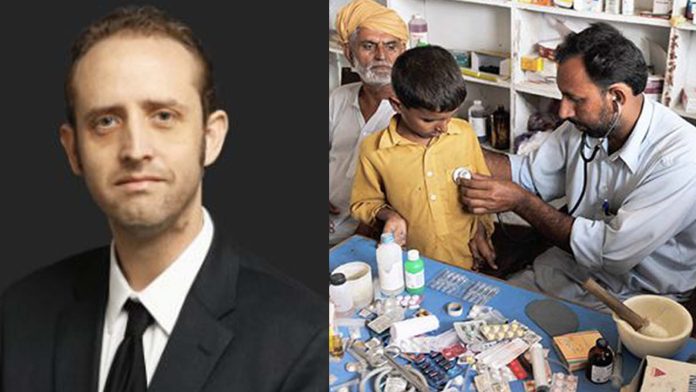Dr. Jonathan Kenigson, FRSA
Introduction – Pakistan’s Healthcare Challenges
Despite a plethora of budgetary setbacks and partisan impasses, Pakistan’s political leadership remains largely committed to achieving universal healthcare (UHC) for the country’s 231 million residents (Shaikh, B. & Ali, N., 2023). Prevailing budgetary allocations directed toward UHC (roughly 1.2% of nominal GDP) remain low in comparison with corresponding expenditures in other developing countries (Lane, C. & Glassman, A., 2007). Because of funding difficulties and staffing shortages in state facilities, the majority of the population is compelled to resort to private care (Shaikh, B. & Ali, N., 2023). This care is often concentrated in major cities, and is prohibitively costly and geographically inaccessible to families of average means, especially those in rural areas of the country. High out-of-pocket costs for outpatient and routine surgical services should be prominent topics for trilateral state-physician-patient collaboration (Khalid et al., 2021; Khalid et al., 2020).
Interventions on a National Level
While it is difficult to determine a shortlist of the most pressing exigencies facing Pakistan’s UHC initiatives at a national level, one may propose several avenues of reform based upon national health statistics. Countrywide practices should focus thoroughly on pandemic prevention – a more cost-effective and administratively uncomplicated alternative to pandemic remediation (Humayun et al., 2021). For instance, legislation to guarantee the improvement of blood transfusion sanitation through careful monitoring and screening of samples would serve to mitigate the proliferation of Hepatitis C among patients (Alaei et al., 2017). On a national scale, it is also critical to address corruption in Pakistan’s healthcare system via government-wide anti-graft reforms (Khan et al., 2020). One such measure would consist of Implementing systems of process oversight and improvement into local operational planning via physician-led, patient-informed local councils (Hussain, 2019).
Local Interventions: The “Polyclinic”
On provincial and local scales, policymakers should consider comparative analysis of healthcare delivery in rural China, in which local “polyclinics” treat a variety of ailments in a local, affordable, outpatient setting (Meghani et al., 2014). In Pakistan, childhood disability and disease should be explored in the polyclinic context, which may – as in China – furnish improvements to the affordability and effectiveness of care (Mahmood et al., 2022; Anser et al., 2020). Staffing shortages could be addressed through domestic, polyclinic-based training to limit the necessity of medical professionals’ leaving vulnerable populations for career advancement.
Polyclinics Improve Staffing Shortages
Polyclinic-based medicine may also serve to mitigate the shortages of doctors and nurses in Pakistan. Doctor : Population, Nurse: Population, and Hospital Bed : Population ratios are all significantly lower than World Health Organization (WHO) recommendations (Ahmed et. al., 2021).
Also Read: Germany uses robots for elder healthcare
There is an absolute shortage of medical professionals and hospital beds, with an even greater dearth of resources in remote towns and villages – a problem that has been exacerbated by the demands of the COVID-19 pandemic on the already overtaxed medical system. Provinces and regions will have to collaborate efficiently with the federal government to remediate staffing shortages (Ahmed et. al., 2021).
Local Care is More Effective, Inexpensive, and Equitable
Although higher quality quantitative research is needed, the localization of healthcare expenditures has been shown to positively influence patient mortality and satisfaction outcomes in Pakistan (Ain et al., 2022). As provided in “National Health Vision 2025,” leveraging information technology and digitalization via virtual internal medicine and dentistry (telehealth) would almost certainly improve state-incurred costs and difficult patient commutes for care (Chaudhary et al., 2022). Because these primary and community-based treatment centers are cheaper, more accessible, and more efficient at treating common and chronic conditions, Pakistan’s government should take measures to enhance the utilization of primary healthcare facilities as opposed to urban specialist hospitals (Shah et al., 2016).
Problems Remediable via Polyclinics
Improvement of rates of routine immunization would reduce preventable mortality and reduce systemic expense incurred in treating preventable conditions (Hussain et al., 2023). Local clinics could be cheaply and effectively equipped to handle treatment noncompliance in cases of microbial diseases that otherwise present significant probabilities of morbidity and mortality (Ali et al., 2016). Maternal and neonatal health outcomes would also be improved through equitable, local, obstetric care (Khan, 2023; Mahmood et al., 2022). Local health clinics should be staffed by domestically-trained generalist physicians with deep personal and cultural roots in communities (Jalil et al., 2017). Continuing education should be provided to physicians and nurses employed by these clinics. As Jalil argues, a community-rooted healthcare system can serve to bridge subtle cultural differences that may sometimes incline patients to eschew care altogether (2017).
Further Readings & Scholarly Sources. Click Here

















